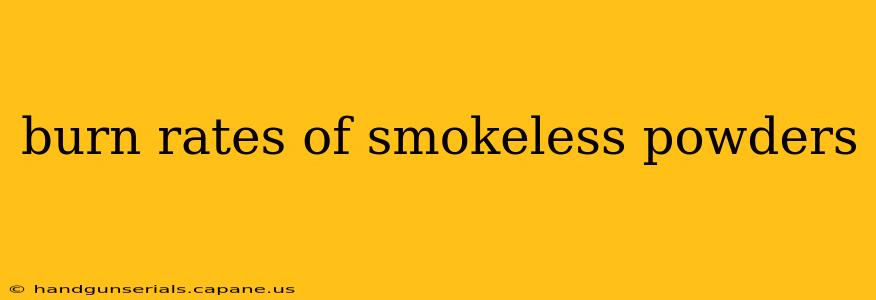Understanding burn rates is crucial for anyone working with smokeless powders, whether you're a firearms enthusiast, a reloading hobbyist, or a professional in the ammunition industry. This comprehensive guide delves into the complexities of smokeless powder burn rates, exploring their characteristics, influencing factors, and practical implications.
What is Burn Rate?
The burn rate of smokeless powder refers to the speed at which the propellant burns within a firearm's chamber. It's typically measured in inches per second (IPS) or millimeters per second (mm/s) and is a critical factor determining the pressure curve generated within the firearm. A faster burn rate translates to a quicker pressure rise, while a slower burn rate results in a more gradual pressure increase.
Factors Influencing Burn Rate
Several factors influence the burn rate of smokeless powder, including:
1. Powder Composition:
The chemical composition of the powder is the primary determinant of its burn rate. Different formulations using various nitrocellulose, nitroglycerin (or other energetic plasticizers), and stabilizers result in vastly different burn characteristics. Manufacturers carefully control these formulations to achieve specific burn rates for different applications.
2. Grain Size and Shape:
The physical characteristics of the powder grains significantly impact their burn rate. Larger grains generally burn slower than smaller grains due to the reduced surface area exposed to the flame. The shape of the grain also plays a crucial role; extruded powders with long, thin grains tend to burn slower than spherical or flake powders. Progressive burning powders, designed with varying densities across the grain, provide a controlled burn rate over time.
3. Powder Density:
The density of the powder, often expressed as bulk density, affects the burn rate. Higher density powders typically burn slower due to increased compaction and reduced surface area.
4. Temperature and Pressure:
Environmental factors such as temperature and the pressure within the firearm's chamber also affect burn rate. Higher temperatures generally increase the burn rate, while increased pressure can lead to both increased and decreased burn rates depending on the powder's composition and grain structure. This is why extreme temperatures can lead to malfunctions.
5. Confinement:
The degree of confinement within the firearm's chamber influences the pressure build-up and, consequently, the burn rate. A tighter chamber leads to faster pressure increases, whereas a looser fit might lead to slightly slower burn rates.
Measuring Burn Rate
Precisely measuring burn rate requires specialized equipment and methodology. Methods include using a closed bomb calorimeter or strand burner, which provide controlled conditions to measure the burning speed under specific pressure and temperature conditions. These measurements are often conducted by powder manufacturers to define the characteristics of their products.
Practical Implications of Burn Rate
The burn rate of smokeless powder is paramount in several areas:
-
Ballistics: It directly impacts muzzle velocity, accuracy, and recoil characteristics. The correct burn rate is essential for optimal performance in specific firearms.
-
Pressure Generation: An improperly matched burn rate can lead to dangerously high chamber pressures, resulting in catastrophic firearm failure.
-
Reloading: Choosing the correct powder for handloading is critical for safety and accuracy. Using a powder with an inappropriate burn rate can lead to malfunctions or dangerous situations.
-
Ammunition Design: In ammunition design, choosing the appropriate burn rate is essential for achieving desired ballistic performance and ensuring safe operation across a range of temperatures and conditions.
Conclusion
Understanding burn rates is vital for safe and effective use of smokeless powders. The interplay of powder composition, grain size, density, and environmental conditions creates a complex system that demands careful consideration. This knowledge is essential for those involved in the development, manufacturing, or safe use of smokeless powder-based ammunition. Remember to always consult manufacturer's data and prioritize safe handling practices.

